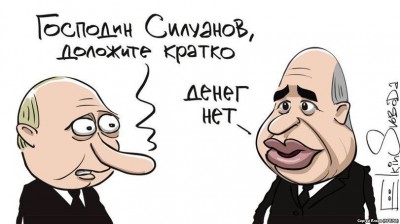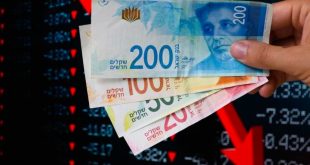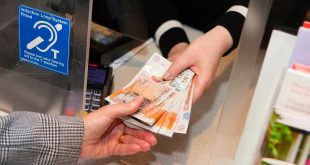…
16 Dec 1947 in Moscow was buzzing like a beehive. Rumors on monetary reform forced people to withdraw all the money from the books, to sweep clean the shelves, to buy anything. The rumors were not groundless — the Soviet Union had a currency reform: on the order it was in the Soviet history of the second, but the scope of obtaining power of money from the population, of course, the first and still unsurpassed…
11 Dec 1947 all district and town departments of the interior Ministry received packets plastered with wax seals: the strict order was that the received packet should be open at 15 o’clock on December 14 in the presence of the higher ranks of the police, heads of financial authorities and savings banks. As it turned out, the secret packages were instructions for the exchange of money. The entire money supply is supposed to convert from 16-22 December 1947.
Exchange subject to all the paper money (1-, 2-, 3-, 5-, 10-, 15- and 20-kopeck coins remain in circulation without changing the nominal value): old banknotes were changed to the new ratio of one new ruble for ten old.
The exchange rate of the deposits in savings banks looked more preferential: deposits of up to three thousand rubles rescheduled one by one. But the deposits from three to ten thousand roubles has varied otherwise: three thousand – one-to-one; all that is over, – in the ratio of nine new three old – one-third “excess” cut. And all that exceeded 10 thousand rubles, halved: the exchange was at the rate of 2 to 1.
The revaluation was to be the bond of the state loans – a reduction factor, of course. At the same time abolished the card system: as promised, radio and Newspapers, the shelves were filled with cheap products.
“The last victim”
As reported in the decree of the Council of Ministers of the USSR and the CPSU(b) on 14 December 1947 On currency reform and the abolition of cards for food and industrial goods,” “when carrying out monetary reform requires some sacrifices.
Most of the victims of the state assumes. But it is necessary that some of the victims took over and the population, especially because this will be the last victim.” In fact it was the opposite: the state has taken, but not “for himself” – himself, laying all the burdens of the reform is on the population. And the victim was not the last.
To this day the Treasury economists-financiers in one voice talking about how vital was the reform and how brilliant it had “Stalin’s iron Commissar” Zverev, the then Minister of Finance.
But if you look, the official justification for the necessity of the exchange of money is difficult to call a clear. The notorious decree of the Council of Ministers of the USSR and the CPSU(b) of 14 December stated that the reform is “to strengthen the ruble” for the abolition of rationing of supply and the transition to a “deployed trade for a single state.
Further, the Kremlin said: in the war years “has dramatically increased the cost of the Soviet state for the maintenance of the army and the deployment of the military industry. Huge military expenditures demanded the release into circulation a large amount of money. The amount of money in circulation has increased significantly… At the same time reduced the production of goods for sale to the public…”
Simply put, the first state to include on the power of the printing press, paying with a population of worthless paper money (which with a card distribution system there is little to buy, and then, shrugging his shoulders, said: we are here wrappers’ve done is throw it back?!
Blame the Nazis
And, of course, told the citizens a terrible secret: it turns out that “German and other occupants were released in a large amount of counterfeit money in rubles, which further increased the surplus of money in the country and has polluted our monetary circulation”. Because, they say, “the result is that the appeal was much more money than is necessary for the national economy, the purchasing power of money fell…”
Simply put, the money in the country more than their commercial software. But that’s not all: the surplus money was used “speculative elements profited during the war and had accumulated considerable sums of money.” But this, angrily the decision, “cannot be allowed”!
So one bottle leaked all: and military spending, and disorder of Finance during the war, and the machinations of the German counterfeiters, and excess money supply in the hands of speculators, and the abolition of the card system of monetary reforms. Yes, dragged the type argument that “everyone does”: “the currency reform is commonplace in all States after great wars.” In parts it seems all right, but in General – “mixed in a bunch of horses, people…”: explanation too much, and not all of them fit together. After all, the crux of the whole argument, if you think about it, is simple: guys, you did a good job, but now we do not need.
So here’s those numbers that are frightened of “iron Stalinist Commissars”: on the eve of war, the appeal of 18.4 billion roubles in cash, but since the printing presses of the factories of Goznak worked non-stop, to January 1, 1946 papers in the country was already four times more – 73.9 billion. Of them, according to Finance Ministry estimates, more than 66 billion was in the hands of the people – they had to withdraw.
Cynical as explained in one of the private documents of the era, “the exchange should be carried out under such conditions that not only ensured the withdrawal from circulation of all surplus money, but in the end the exchange was basically cancelled, the money savings from individuals who profited during the war on speculation and other illegal means”.
But even simple arithmetic shows that these billions could not be in the hands of only “speculative elements, profited during the war. If you divide those 66 billion by the population, you get about 380-390 rubles of cash per capita – that is, if you count the children. And the old soul had no more than 600 rubles – the money is insignificant. And the Finance Minister Zverev to take wanted, because nothing they are not secured…
Only not in alone cash rubles was the problem, but also that the Stalinist state at large owe to the public. We are talking about home loans 1930-1940-ies: loan of industrialization – there were three issues, the loan “five-year plan in 4 years”, the four issues of the loan of the 3rd five-year plan, the loan strengthen the defense, four issues of the loans of the war years.
And because none of these loans actually were not voluntary: people are simply forced to give part of their earnings, and even pay the bonds. It is estimated that on average every resident of the Soviet Union was forced to give away Treasury bonds for two-three salaries per year!
Scam bonds
In 1927 the USSR had 6 million subscribers to its loans at the beginning of 1941, 60 million, almost the entire adult population of the country. In early 1946, subscribers to the loans were for 70 million. The state loan and they gave much: with this procedure, the state milked before the war was 50 billion rubles, and during the war – another 76 billion rubles. And all this had to be repaid, but didn’t want to.
In the Council of Ministers and the CPSU(b) on 14 December 1947 openly and said: “a Significant part of public debt loans was formed during the war, when the purchasing power of money has fallen, and meanwhile, after the currency reform, the state will repay this debt of full ruble”. How will, wait!
At the direction of tov. Stalin’s Minister Zverev austere implemented proven technique thrown: this must – forgive all. In fact, the Kremlin did natural Scam: bonds loans prewar, war and postwar (reconstruction and development of the national economy) were exchanged for bonds of the new loan in the ratio of three rubles in the bonds of the old issue for one new ruble bonds. A premium bond 1938 swapped for new bonds at all in the ratio of five old rubles for one new ruble.
Rate the grace of money: a slight wave of a finger of the leader the duty of the state to the population has decreased three to five times! However, his leader was not going to pay: maturity of new bonds received in exchange of the old, was extended for 10 and 20 years…
Exchange lost primarily those which supposedly cared Stalin with its main financier Zverev: highly skilled workers, farmers, intellectuals and technical clerks. Because the majority of the population no deposits in savings banks was not because the bitter experience of the people prefer usually to keep their savings in the pod and under the mattress. And to the delight of the financiers, approximately one-third of the money supply – more than 25 billion old rubles – was never presented for exchange.
Almost officially considered part of the population simply did not dare to declare their cash savings, so as not to answer indiscreet questions about the sources of their origin. But much more real a different explanation: the trade deadline was ridiculously tiny, huge country, and communications – knows what. So a significant part, especially villagers, did not have time to present the money to the exchange, after failing to bring their “potbelly” exchange offices.
The villagers have lost most of all because not diminished to rip off their taxes to the state. But decreased and accumulated in these tax – receivable- transferred her to new money one to one. As promised, has not declined and the price of essential goods, such as not dropped the price in the trade commercial and the collective. But decliners were quality goods when evaporated from the state trade, and then to emerge in commercial trade at prices even higher.
Those who at one time believed the public call to “Put your money not in the capsule, and in savings books”, rushed to withdraw money from deposits, while those tenfold “not lost”. In savings banks lined up huge queues. But there is already prepared and worked tirelessly.
Information on the number of withdrawals amounts to almost hourly received in the Kremlin. When it became clear that the bulk of the depositors money in savings banks were only minor, the money supply, the government announced the main condition savings devalued in a privileged mode in comparison with cash (small deposits — one-to-one, and more or less significant about twice).
The announcement was made on 15 December in the afternoon, on the eve of the entry of the Directive into force. And the period for the exchange established compressed from 16 to 22 December. So together with the already “trimmed” depositors queued on the exchange has invited everyone who had money.
But the Stalinist nomenklatura: the officials of the party, Soviet and economic bodies, the executives of the financial and commercial structures, the major offices, the MVD and MGB – they are from this reform was even in the win. As, however, and those are the biggest “speculative elements”, to destroy whom this reform is supposedly about. The whole gang of brothers, being informed early, to be able to throw my cash into many small deposits, registered on figureheads.
So the packages went to the addresses…
Sunday December 14, 1947, when the shops and savings banks were closed, began currency reform, designed to remove “excess” – the amount that, by some miracle, remained Soviet citizens a day or two to advance.
Cash had to be exchanged at a ratio of 10:1, and the contribution from three discharges: up to 3000 rubles – 1:1, from 3001 to 10 000 rubles – 3:2, more than 10 000 to 2:1. Monday 15 December was banned all financial transactions. It was a confiscation.
The leak occurred in Leningrad, but the panic began in Moscow. 3 weeks before the reform of the nomenclature took the shops by storm and bought up every last nail, but the main events unfolded in savings banks: a more knowledgeable fellow opened new deposits and crushed the old one.
For bribes with the agreement of the management of savings banks with effect from 15 December, the money to the accounts (small contributions) were paid retroactively (in a rural location and did it right on the street and even in fictitious names). Also tried to repay loans and borrowings advance to pay the rent and make other payments, to save their money.
The people swept up in trying to save at least some part of their blood.For bribes with the agreement of the management of savings banks with effect from 15 December, the money to the accounts (small contributions) were paid retroactively (in a rural location and did it right on the street and even in fictitious names). Also tried to repay loans and borrowings advance to pay the rent and make other payments, to save their money.
Some took feverishly to change a small thing on trams and buses: a metal money devaluation was not subject. Jigs only had time to pour the delivery. But how many thus it was possible to namenyat? The bulk of the poor rushed to the shelves. By evening the shops were bought up everything. Went even years the product lying, like some chandeliers. Pharmacies have snapped up almost all of the drugs swept the entire stock of bandages and iodine.
From the message of MIA of the USSR, the Politburo of the CPSU(b), 30 November 1947:
“In the last days in Moscow rumours that in the next few days will be exchanged with existing money to new money from the calculation of 10-12 cents for 1 ruble, and that at the same time we will increase the price of industrial goods sold at planned prices. In this regard, in Moscow there was a massive rush of customers at shops selling industrial goods. Especially increased the demand for expensive goods second-hand stores…
In furniture stores Nos. 115, 117 and 131 had a headset of furniture worth 30, 50, 60 and 101 thousand rubles. Headsets cost 30, 50 and 60 thousand have already been sold, and a set of 101 thousand rubles, which for three or four years have not been sold, there are four buyer…”
Citizens convicted of trying to preserve their savings, was supposed to be brought to trial as embezzlers of state property, which was threatened with imprisonment for 10 years. However, few of the senior contributors were prosecuted: most were paid not by imprisonment, and paying fines and a reprimand on the party line.
But many workers Commerce and supplies was punished too severely – 12 years imprisonment 15 years imprisonment and others Heads of stores and databases Orsa contributed personal funds under the guise of the proceeds from the sale of vodka and the vodka itself is concealed.
Help
After the lifting of the cards at the end of 1947, when the salaries of most of the urban population in 500-1000 rubles a kilogram of rye bread cost 3 rubles, wheat – 4 rubles 40 kopecks, kilogram of buckwheat – 12 rubles, sugar – 15 roubles, butter – 64 rubles, sunflower oil – 30 rubles, ice cream walleye – 12 roubles, coffee – 75 roubles; a liter of milk – 3-4 rubles; a dozen eggs – 12-16 rubles (depending on the category, which had three); a bottle of beer “Zhiguli” – 7 rubles; half-liter bottle of “Moskovskaya” vodka – 60 rubles.
“True”:
“With a sense of great satisfaction met the Soviet people the resolution of Council of Ministers of the USSR and the CPSU(b) “On the currency reform and the abolition of cards for food and industrial products”, aimed at eliminating the consequences of war, to further lift the national economy of our country, improvement of material welfare.
The working people of our country thank Bolshevik party, the Soviet government, the great leader and teacher, mother of Stalin for the paternal care about the needs of the people, for the good and happiness of the people. In response to this concern grows a new wave of labor enthusiasm, inexhaustible creative activity of the Soviet people”.
But as he recalled the events the writer Vyacheslav Kondratyev:
“All the shops and commercial, and commissions, and Department — covered with bursts. The day before yesterday at the former St. Nicholas in the store “Optics” took snapped up the binoculars. Beautiful Zeiss binoculars — the dream of all middle commanders at the front — bought now some wench, peasants, and took not one or two — dozens, a hundred rubles apiece.
For a week, as savings banks in the crush, who made money, who took it, unknown to anyone, than it is reform, and how best… Well, and in the evening restaurants commercial stormed out of combat, screaming, swearing, almost a scuffle at the door…”
But if the city is so desperate movements could give at least some result, then the villagers that it was urgent to get to the nearest town, and did not Shine. (Remember unparliamentary expressions stayed with us then relative — a soldier from the Far East: just before the reform they were given a salary for several months).
The Newspapers came out with the government’s appeal: people called to treat the reform as “the last and sacrifice”. Loudspeakers rang approving responses “, and, juggling the figures proved what a tremendous win brought the devaluation of workers. “A fully fledged new ruble rang the Golden bell!” — covered Newspapers, publishing samples of the new banknotes, which, starting with the tens, there was a portrait of Lenin.
Meanwhile, the icy December wind drove through the streets of the piles of red trecator and other already useless bills. These papers were even in our old yard, entirely surrounded by communal. Everyone in the house knew it fly “subcutaneous” two lived it the drug dealers, fences. But they soon came back again the money stolen. What could I do to other people — those in the post-war years lived by his labor?
But the prices from the late forties until the death of Stalin was annually reduced!” — remember sometimes today.
Reduced. And pretty much: Cologne, matches, caramel, galoshes, needles. Weakened the autumn vegetables and fruits, which is equivalent to the usual seasonal price fluctuations. But the price lists on bread, cereals, meat, fish, butter, eggs changed very reluctantly.
But in the same December 1947, closed by the decision of the Politburo of the CPSU(b) was several times raised the salary to all the leaders of the country. However, at the insistence of Stalin, the ” big wigs were somewhat reduced free access to material goods. But after a few months, this temporary loss was covered by a regular grant of envelopes with a temporary allowance.
For example, the Minister or zavotdelom of the Central Committee with the official salary of 5,000 rubles received an envelope with 20,000 rubles with which to pay taxes and partvznosy not required.







